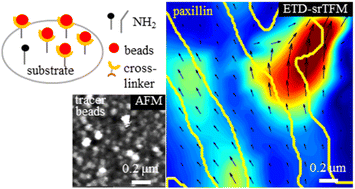Super-resolution traction force microscopy with enhanced tracer density enables capturing molecular scale traction†
Abstract
Cell traction mediates the biochemical and mechanical interactions between the cell and its extracellular matrix (ECM). Traction force microscopy (TFM) is a powerful technique for quantitative cellular scale traction analysis. However, it is challenging to characterize macromolecular scale traction events with current TFM due to the limited sampling density and algorithmic precision. In this article, we introduce a super-resolution TFM by utilizing a novel substrate surface modification method. Our TFM technique achieved a spatial resolution comparable to fluorescence microscopy and precision comparable to the rupture force of an integrin–ligand bond. Correlated imaging of TFM with fluorescence microscopy demonstrated that the residing paxillin highly correlated with traction while α5 integrin was located differently. Time-lapse TFM imaging captured a transient traction variation as the adhesion protein passed by. Thus, the novel super-resolution TFM benefits the studies on cellular biochemical and mechanical interactions.



 Please wait while we load your content...
Please wait while we load your content...